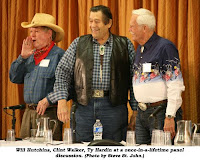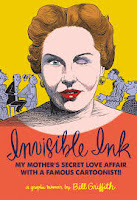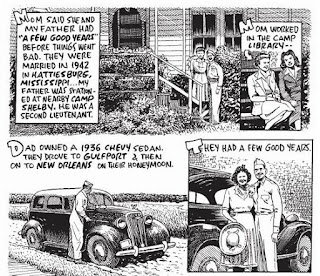
While wandering around 1880 Town in Midland, South Dakota today, I came across a copy of the famous photo of the Warner Bros.' TV western stars drawing their pistols. What made this one special was that it was autographed by Ty Hardin, who at that point was playing Bronco Layne in a series that had originally been a replacement for
Cheyenne, when WB had contract trouble with Clint Walker, and now was rotating through schedule spots with Cheyenne and Will Hutchins'
Sugarfoot.

But it reminded me that Hardin died last week, and I wanted to write something then, so it's a good excuse to say a couple of things about him now. One thing I hadn't known was that he was a football player. His obits said he got a scholarship to Blinn Junior College, then attended Dallas Bible Institute before joining the Army. Then he enrolled at Texas A&M and, so the story goes, played for Bear Bryant there. It's hard to check, because he didn't graduate, but the stories I read said he played tight end, in the days before that was a position. He registers no stats as a receiver from 1954-56, when A&M had John David Crow, Bobby Joe Conrad, and Jack Pardee. I did find a picture of him in a football uniform, but I don't know who's it was and he looks younger than a post-Army Ty Hungerford.

What I did know a bit about was how fragile his career was. It resembles, in some ways, Clint Eastwood's early career, except that Hardin made a couple of bad decisions, whereas Clint made a couple of good ones. But they got into TV by luck, more or less. Both were hired originally because of their good looks, as beefcake. Clint was one of the last of Universal's apprentices, and he had been trying to get into acting. Hardin (or Orison Whipple Hungerford, Jr. as he then was named, though Ty was his family nickname) was spotted by a Paramount scout at a costume party (he was a cowboy) and was signed to a contract. He had bit parts in a couple of films, including
Last Train To Gun Hill, billed as Ty Hungerford, when, like Clint, he got lucky and landed a TV gig.

Hardin met John Wayne, and when he tried to get the Ricky Nelson part in Howard Hawks'
Rio Bravo. Wayne introduced him to Hawks, who was with William Orr of Warners. Hawks didn't give him the part, but Orr soon bought his contract. Warners changed his name to Hardin, gave him acting lessons, and introduced him into the
Cheyenne series as Cheyenne's cousin.

He was an instant hit, and Bronco ran for four years. His best film part was in Merrill's Marauders, and it looked like he was on his way. After Warners, he was getting 'exposure' roles in big films like
Battle Of The Bulge and
PT 109, where he had a blonde goatee, but not yet any serious starring parts.
Then Hardin made a couple of bad decisions. One was to pass on a western role offered by an Italian director, Sergio Leone. He wasn't the only actor to either pass or want too much money, and of course the part eventually went to Clint. The next one was to pass on the TV show
Batman, ironically because he had a comittment to film in Spain, on a sort of spaghetti western, Hugo Fregonese's Argentinian
Savage Pampas.

Hardin played the lead in
Riptide, a series that was made in and set in Australia, but was shown in the US. He was in
Custer Of The West, and in a weird British circus horror film,
Beserk, with Joan Crawford. But his career stalled. He made three disposable spaghetti westerns in 1971, and then worked only intermittently, though he had a part in a TV movie remake of
Red River, which starred James Arness and Bruce Boxleitner in the John Wayne and Montgomery Clift roles, but had parts for other old western TV stars like Hardin, Guy Madison, Robert Horton and John Lupton. Hardin was tall and good looking, but unlike Wayne or Eastwood, never really learned to control his image on screen.

Off screen was another story. His third wife was Marlene Schmidt, the East German-born Miss Universe of 1961. Ironically, she went into the film business after they divorced. In all Hardin had eight wives, and ten children. Which may help explain why he had problems with the IRS, which helps explain why he helped found the Arizona Patriots, which sounds like football team but was an anti-tax, anti-government Tea Party type group that evolved into a militia. In 1986 they were raided, and accused of planing to attack a federal office in Utah. Hardin wasn't charged with any crimes, but the group disbanded.
The photo above is not Hardin as a militia leader, but a fan show where he appeared alongside Clint Walker and Will Hutchins, and he was the only one not quite in costume. I find it tremendously nostalgic, especially now, viewing a Wild West town that only moderately appeals to my 13 year old.

Hardin died at 87. It is easy to imagine scenarios in which he was a successful film actor, or a busy TV star. But his other difference from Clint was lacking Clint's study of the business, and his nous for it. Clint's acting and directing careers are actually meshed into his producing career; he became virtually a studio himself; this would have been beyond Hardin. On the other hand, there aren't many people, not even Clint, whose obituaries will say 'he is survived by his eighth wife; his previous seven marriages all ended in divorce.' And I found, while writing this, a reverse angle of that famous photo, an earlier unused take. Those were the days.














